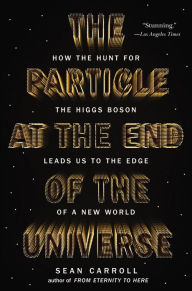Lisa Randall studies theoretical particle physics and cosmology at Harvard University, where she is Frank B. Baird, Jr., Professor of Science. A member of the National Academy of Sciences, the American Philosophical Society, and the American Academy of Arts and Sciences, she is the recipient of many awards and honorary degrees. Professor Randall was included in Time magazine's "100 Most Influential People" of 2007 and was among Esquire magazine's "75 Most Influential People of the 21st Century." Professor Randall's two books, Warped Passages (2005) and Knocking on Heaven's Door (2011) were New York Times bestsellers and 100 Notable Books. Her stand-alone e-book, Higgs Discovery: The Power of Empty Space, was published in 2012.
Knocking on Heaven's Door: How Physics and Scientific Thinking Illuminate the Universe and the Modern World
by Lisa Randall
Paperback
(Reprint)
- ISBN-13: 9780061723735
- Publisher: HarperCollins Publishers
- Publication date: 10/02/2012
- Edition description: Reprint
- Pages: 480
- Sales rank: 82,016
- Product dimensions: 5.40(w) x 7.86(h) x 1.11(d)
What People are Saying About This
.
“Science has a battle for hearts and minds on its hands….How good it feels to have Lisa Randall’s unusual blend of top flight science, clarity, and charm on our side.”
—Richard Dawkins
“Dazzling ideas….Read this book today to understand the science of tomorrow.”
—Steven Pinker
The bestselling author of Warped Passages, one of Time magazine’s “100 Most Influential People in the World,” and one of Esquire’s “75 Most Influential People of the 21st Century,” Lisa Randall gives us an exhilarating overview of the latest ideas in physics and offers a rousing defense of the role of science in our lives. Featuring fascinating insights into our scientific future born from the author’s provocative conversations with Nate Silver, David Chang, and Scott Derrickson, Knocking on Heaven’s Door is eminently readable, one of the most important popular science books of this or any year. It is a necessary volume for all who admire the work of Stephen Hawking, Michio Kaku, Brian Greene, Simon Singh, and Carl Sagan; for anyone curious about the workings and aims of the Large Hadron Collider, the biggest and most expensive machine ever built by mankind; for those who firmly believe in the importance of science and rational thought; and for anyone interested in how the Universe began…and how it might ultimately end.
Customers Who Bought This Item Also Bought
-
- Warped Passages: Unraveling…
- by Lisa Randall
-
- Physics for Future Presidents:…
- by Richard A. Muller
-
- Time Reborn: From the Crisis…
- by Lee Smolin
-
- Dancing Wu Li Masters: An…
- by Gary Zukav
-
- "Surely You're Joking…
- by Richard P. FeynmanBill GatesRalph Leighton
-
- Why Does E=mc2?: (And Why…
- by Brian CoxJeff Forshaw
-
- Quantum Physics For Dummies
- by Steven Holzner
-
- The Physics of Superheroes:…
- by James Kakalios
-
- The Holographic Universe: The…
- by Michael Talbot
-
- Six Not-So-Easy Pieces:…
- by Richard P. FeynmanRobert B. LeightonMatthew Sands
-
- The Particle at the End of the…
- by Sean Carroll
-
- Paradox: The Nine Greatest…
- by Jim Al-Khalili
-
- How to Teach Relativity to…
- by Chad Orzel
-
- Six Easy Pieces: Essentials of…
- by Richard P. Feynman
-
- For the Love of Physics: From…
- by Walter LewinWarren Goldstein
-
- The Road to Reality: A…
- by Roger Penrose
-
- Physics I for Dummies
- by Steven Holzner Ph.D.
-
- The Pleasure of Finding Things…
- by Richard P. FeynmanFreeman DysonJeffrey RobbinsJeffrey Robbins
Recently Viewed
From Randall (Theoretical Physics/Harvard Univ.; Warped Passages: Unraveling the Universe's Hidden Dimensions, 2006), a whip-smart inquiry into the scientific work being conducted in particle physics.
The author examines some fairly recondite material—the philosophical and methodological underpinnings of the study of elementary particles (with a brief foray into cosmology)—and renders it comprehensible for general readers. She brings a thrumming enthusiasm to the topic, but she is unhurried and wryly humorous. She explains how physicists conduct their theoretical studies, the logic involved and the confidence that comes only in what's verified or deduced through experimentation. That knowledge must always be open to change, surrounded as it is by an amorphous boundary of uncertainties, where research is conducted in a state of indeterminacy, testing and questioning to ascertain veracity and implications (which includes investigating the likes of string theory, which doesn't yield experimental consequences but may provide new ways of thinking). Randall brings great clarity to the application of theory. Not only will readers come to feel comfortably familiar with scaling—why, for instance, Newton's laws work on one scale but not another—or how the Large Hadron Collider will provide access to fundamental particles, but appreciate how one "sees" a subatomic particle when visible light's wavelength is too big to resolve it. While much of the book concerns the behavior of quarks, leptons and gauge bosons, the author ranges freely into the advantages and disadvantages of aesthetic criteria in science, the importance of symmetry and the creation and nature of black holes, black energy and black matter: "Why should all matter interact with light? If the history of science has taught us anything, it should be the shortsightedness of believing that what we see is all there is."
A tour of subatomic physics that dazzles like the stars.


















